Pearl Harbor Facts and Issues
The following article is in response to a request by a reader for facts and issues regarding Pearl Harbor.
How America Changed After Pearl Harbor
The December of 1941 radically altered America and its global role
By MICHAEL MORELLA
January 6, 2012
On Dec. 7, 1941, radios buzzed with the news that several hundred Japanese planes attacked a U.S. naval base at Pearl Harbor in Hawaii, killing more than 2,400 Americans as well as damaging or destroying eight Navy battleships and more than 100 planes. Though it would be some time before people learned the full scope of the damage, within days a once-distant war in Europe and the Pacific became a central part of life in the United States, affecting politics, business, media, and entertainment. In his new book, December 1941: 31 Days That Changed America and Saved the World, Craig Shirley offers a day-by-day chronicle of the full month and recounts Pearl Harbor’s political, economic, and cultural implications as they happen. Shirley, the president and CEO of a Washington, D.C., area public relations firm and author of two books on Ronald Reagan, recently spoke with U.S. News about how Americans responded to Pearl Harbor in 1941 and what its legacy is 70 years later. Excerpts:
Why did you decide to recount all of December 1941?
There have been many fine books on Pearl Harbor. But nobody has ever done a book about the month of December 1941 and the radical changes that happened in this country between the 1st and the 31st. I thought it would be fun for me and fun for the reader to see what America goes through in those 31 days.
[Read more Book Club interviews by subscribing to U.S. News Weekly, now available on the iPad.]
What was life like for Americans in early December 1941?
On Dec. 6, 1941—it was a Saturday—Americans were listening to the radio, as all Americans did at that time. They were listening to local programming—news, farm reports, game shows, children’s [programs], music contests, talent shows, things like that. In those days, the average American went to the movies twice a week. And the movies that they may have been seeing that night would have been Citizen Kane or The Maltese Falcon or Dumbo. But they weren’t thinking about war. They really weren’t thinking about war in the Pacific—that was the farthest thing from their minds. They were thinking about the war in Europe, but they weren’t thinking about their involvement in the war in Europe.
How were diplomatic relations with Japan?
Extremely tense. The Japanese had become so much more militaristic over the previous 10 years. We were feverishly negotiating. The Japanese broke off diplomatic relations with the United States, but nobody interpreted that as a prelude to war.
What changed after the attack on Pearl Harbor?
Within a matter of hours of the attack, America is moving quickly to get on a war footing. American attitudes about the war change radically, [as do] American attitudes about the economy, about giving to the war. The war is not part of the culture; the war is the culture. Everything is viewed through the prism of the war effort.
[Read: Barack Obama Commemorates Pearl Harbor Attack]
How so?
Virtually all movies have a war theme. Virtually everybody gets up in the morning thinking, what can I do to help the war effort? Children are doing scrap drives, paper drives, metal drives, rubber drives, grease drives. Nobody has a new car for a long time because Detroit stops making new cars. There are stricter regulations on travel for a lot of people, especially Japanese-Americans, German-Americans, Italian-Americans. San Francisco and Los Angeles are under constant rumors of being bombed.
What did contemporary leaders learn from the attack on Pearl Harbor?
That the world is a very complex place. I don’t think it was American weakness that put us into World War II; duplicity by the Japanese is what put us into the Pacific war and arrogance by Nazi Germany put us into the European war.
Seventy years after entering World War II, the United States is finishing a war in Iraq. Do you think that is the right move?
Yes. A lesson that I think has been lost on current American civilian leaders is that [Gen. Douglas MacArthur] knew that Caesar and Napoleon and others had failed as conquerors of occupied countries because their policies were so harsh. He didn’t make that mistake in Japan. I think we’ve done a good job in Iraq. But it remains to be seen.
[Read the U.S. News debate: Was The Iraq War Worth It?]
What will surprise readers most about this book?
How quickly and actually, in a magnificent sort of way, we become the arsenal of democracy. Probably because of all the competing interests of today it could never happen. In December [1941], the Office of Production Management says to Detroit, says to the Big Three automakers, “You’re no longer going to build cars, you’re going to start building airplanes.” They’re doing this in less than a month out of fabricated auto parts. That was happening across America, across industry. The outpouring from American people and the faith in their government and in their military and in their president, which was bipartisan, really did exist.
- http://www.usnews.com/opinion/articles/2012/01/06/how-america-changed-after-pearl-harbor_print.html
Fact Sheet: Pearl Harbor
The Japanese attack on Pearl Harbor began at 7:55 am on December 7, 1941. Japanese naval forces compiled for the raid included 4 heavy aircraft carriers, 2 heavy cruisers, 35 submarines, 2 light cruisers, 9 oilers, 2 battleships and 11 destroyers.
The attacking forces came in two waves, the first consisting of 183 aircraft which included 40 torpedo planes, 49 level bombers, 51 dive bombers and 43 fighters. The second wave included 170 planes, 54 of them level bombers, 80 dive-bombers and 36 fighters. Over 350 Japanese planes were involved in overall attack, which surprised the United States. At the end of the day, over 2,000 men lost their lives.
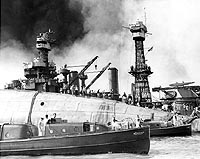
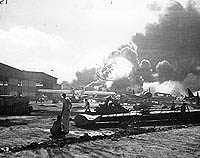
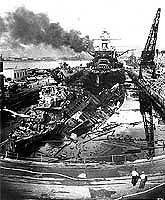 from left:
from left:
USS Maryland and USS Oklahoma after the attack on Pearl Harbor.
Sailors watch USS Shaw explode from Ford Island.
Wrecked destroyers USS Downes and USS Cassin in dry dock for repairs after the attack
Battleships
A warship used mainly for naval bombardment and protection of the fleet against air and surface attacks. Roughly equal to the size of three football fields, they floating fortresses eventually were replaced by aircraft carriers. Battleships were named for states.
Cruisers
Smaller than a battleship, cruisers are mainly deployed to conduct raids and protect members of the task force from enemy ships with naval bombardment and gunfire. Cruisers were named for territories, islands, cities and towns.
Destroyers
Small, highly maneuverable and lightly armored. Usually nicknamed the “tin can,” destroyers are used to conduct anti-submarine operations. Destroyers were named for deceased Navy and Marine Corps personnel or distinguished civilians.
U.S. Personnel Casualties
Service Killed Wounded Total
Navy 2008 710 2718
Army 218 364 582
Marines 109 69 178
Civilians 68 35 103
Summary of U.S. Ship Damage
Battleships
Arizona sunk, total loss
California sunk, raised, repaired May 1944
Maryland damaged, repaired Feb. 1942
Nevada heavily damaged, repaired Dec. 1942
Oklahoma capsized, total loss
Tennessee damaged, repaired Mar. 1942
West Virginia sunk, raised, repaired July 1944
Pennsylvania slightly damaged, repaired Aug. 1942
Destroyers
Cassin heavily damaged, rebuilt Feb. 1944
Downes heavily damaged, rebuilt Nov. 1943
Helm damaged, repaired Jan. 1942
Cruisers
Helena heavily damaged, repaired June 1942
Honolulu damaged, repaired Jan. 1942
Raleigh heavily damaged, repaired July 1942
Minecraft
Oglala sunk, raised, repaired Feb. 1944
Auxiliaries
Curtis damaged, repaired Jan. 1942
Sotoyomo sunk, raised, repaired Aug.1942
Utah capsized, sunk
Vestal heavily damaged, repaired Feb. 1942
YFD-2 sunk, raised, repaired May 1942
U.S. Aircraft Damage Summary: Lost and Damaged Aircraft
Navy 92 31
Army Air Corps 77 128
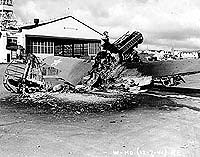
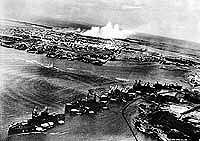
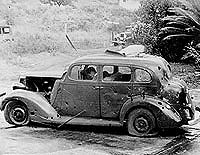
The burned out wreck of a P-40 pursuit aircraft at Wheeler Air Force Base.
Battleship Row under attack by Japanese, December 7, 1941
Three civilians killed while on their way to work by shrapnel from a Japanese bomb.
Ships at Pearl Harbor Lost in World War II
Arizona (BB 39) December 7, 1941
Blue (DD 387) August 23, 1942
Gamble (DM 15) February 18, 1945
Grebe (AM 43) December 5, 1942
Helena (CL 50) July 6, 1943
Henley (DD 391) October 3, 1943
Hull (DD 30) December 18, 1944
Jarvis (DD 393) August 9, 1942
Monaghan (DD 354) December 18, 1942
Neosho (AO 23) May 11, 1942
Oklahoma (BB 37) December 7, 1941
Perry (DMS 17) September 13, 1944
Reid (DD 369) December 11, 1944
Thornton (AVD 11)* May 2, 1945
Tucker (DD 374) August 4, 1942
Utah (AG 16) December 7, 1941
Ward (DD 139) December 7, 1944
Wasmuth (DMS 15)* December 29, 1942
Worden (DD 352)* January 12, 1943
PT 22* January 12, 1943
PT 28* January 12, 1943
Japanese Ships Assigned to “Hawaii Operation”
Akagi June 5, 1942 Midway
Kaga June 4, 1942 Midway
Shokaku June 19, 1942 Philippine Sea
Zuikaku October 25, 1944 Leyte Gulf
Hiryu June 5, 1942 Midway
Soryu June 4, 1942 Midway
Hiei November 13, 1942 Guadalcanal
Kirishima November 15, 1942 Guadalcanal
Chikuma October 25, 1944 Leyte Gulf
Tone July 24, 1945 Kure
Abukuma October 26, 1944 Surgao Strait
Katori February 17, 1944 Truk
Akigumo April 11, 1944 Celbes Sea
Arare July 5, 1942 Aleutians
Hamakaze April 7, 1945 South of Kyushu
Isokaze April 7, 1945 South of Kyushu
Kagero May 8, 1943 Solomons
Kasumi April 7, 1945 South of Kyushu
Sazanami January 14, 1944 Yap
Shiranuhi October 27, 1944 Leyte Gulf
Urakazi November 21, 1944 Formosa
Ushio Surrendered at Yokosuka Naval Base
http://www.history.navy.mil/branches/teach/pearl/aftermath/facts.htm